Post by Eaglehawk on Nov 11, 2019 7:16:12 GMT
Emperor Penguin - Aptenodytes forsteri

Scientific classification
Kingdom: Animalia
Phylum: Chordata
Class: Aves
Order: Sphenisciformes
Family: Spheniscidae
Genus: Aptenodytes
Species: Aptenodytes forsteri
The Emperor Penguin (Aptenodytes forsteri) is the tallest and heaviest of all living penguin species. It is endemic to Antarctica, and is the only penguin species that breeds during the Antarctic winter. Emperor Penguins mainly eat crustaceans (such as krill) but also occasionally take small fish and squid. In the wild, Emperor Penguins typically live for 20 years, but some records indicate a maximum lifespan of around 40 years. The Emperor Penguin should not be confused with the closely related King Penguin or the Royal Penguin.
Ecology and behavior
Emperor Penguins are social animals, both foraging and nesting in groups. In severe weather the penguins huddle together for protection. They may be active day or night. Mature adults travel throughout most of the year between the nesting area and foraging areas in the ocean. From January to March, Emperor Penguins disperse into the oceans, traveling and foraging in groups. It is estimated that there are at least 250,000 Emperor Penguins, distributed into as many as 40 independent Antarctic colonies.
They normally dive to between 150 and 250 m (490 to 820 ft), although they can venture deeper, the deepest diving on record being 565 m (1870 ft). The longest they can hold their breath when underwater is 15 to 20 minutes. Their swimming speed is 6 to 9 km/h (4 to 6 mph), but they can achieve up to 19 km/h (12 mph) in short bursts. One of their feeding strategies is to dive to about 50 m (164 ft), where they can easily spot the sub-ice fish, Pagothenia borchgrevinki, swimming against the under surface of the sea-ice, which they then catch. They then dive again and repeat the sequence about half a dozen times before surfacing to breathe. They may also blow bubbles into the cracks in the ice to drive out the hiding fish.
On land they alternate between walking with a wobbling gait and sliding over the ice on their bellies, propelled by their feet and their flipper-like wings.
As a defense against the cold, Emperor Penguins stand in compact huddles (also known as the turtle formation) ranging in size between ten and many hundreds of birds, each leaning forward on a neighbor. Those on the outside tend to shuffle slowly around the edge of the turtle producing a slow churning action, giving each bird a turn on the inside and the outside.
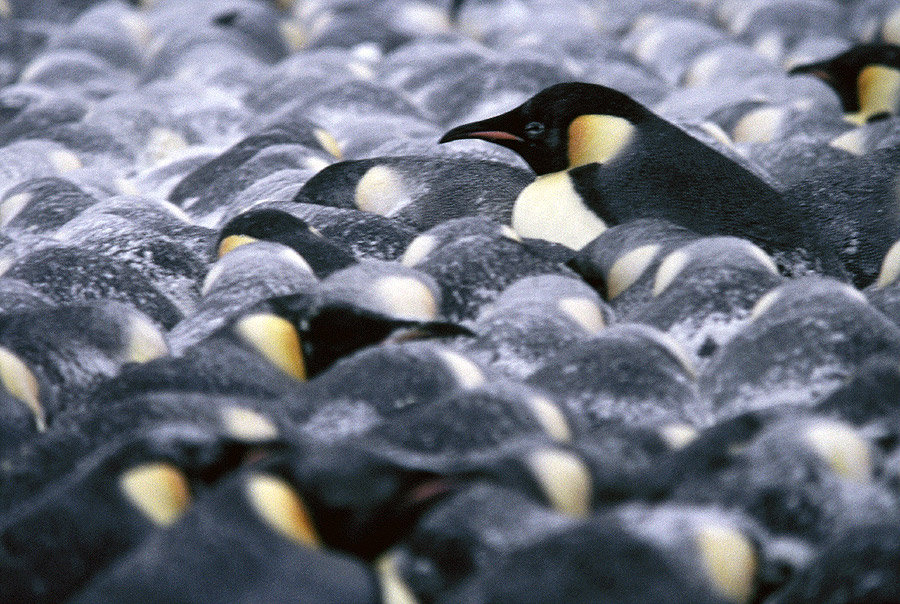
Predators
In the wild, the Emperor Penguin's predators include birds, which prey on chicks and eggs, and aquatic mammals which prey upon both chicks and adult penguins. The primary bird predators are the Antarctic Giant Petrel (Macronectes giganteus) and the Skua. The primary aquatic mammal predators are the Leopard Seal, and Orca.
Reproduction
Emperor Penguins first begin to breed at approximately five years of age. Emperor penguins travel about 90 km (56 mi) inland to reach the breeding site. The penguins start courtship in March or April, when the temperature can be as low as –40°C. Emperor Penguins are serially monogamous. They have only one mate each year, and stay faithful to that mate. However, the next year, most end up with different mates. Although they attempt to locate the previous year's mate in the next breeding season, most cannot find each other and choose a new mate.
In May or June, the female penguin lays one 450 gram (1 lb) egg, but at this point her nutritional reserves are exhausted and she must immediately return to the sea to feed. Very carefully, she transfers the egg to the male, who incubates the egg in his brood pouch for about 65 days consecutively without food by surviving on his fat reserves and spending the majority of the time sleeping to conserve energy. The transfer of the egg can be awkward and difficult, and many couples drop the egg in the process. When this happens, the chick inside is immediately lost as the egg cannot withstand the low temperatures on the icy ground. To survive the cold and winds of up to 200 km/h (120 mph), the males huddle together, taking turns in the middle of the huddle. They have also been observed with their backs to the wind to conserve body heat. If the chick hatches before the mother's return, the father sets the chick on his feet and covers it with his pouch, feeding it a white, milky substance produced by a gland in his esophagus.
After about two months, the female returns. She finds her mate among the hundreds of fathers via his call and takes over caring for the chick, feeding it by regurgitating the food that she has stored in her stomach. The male then leaves to take his turn at sea. His trip is slightly shorter than before, because the melting of ice in the summer gradually decreases the distance between the breeding site and the open sea. After another few weeks, the male returns and both parents tend to the chick by keeping it off the ice and feeding it regurgitated food. About two months after the egg hatches, as the weather becomes milder, the chicks huddle in a crèche for warmth and protection, still fed by their parents.
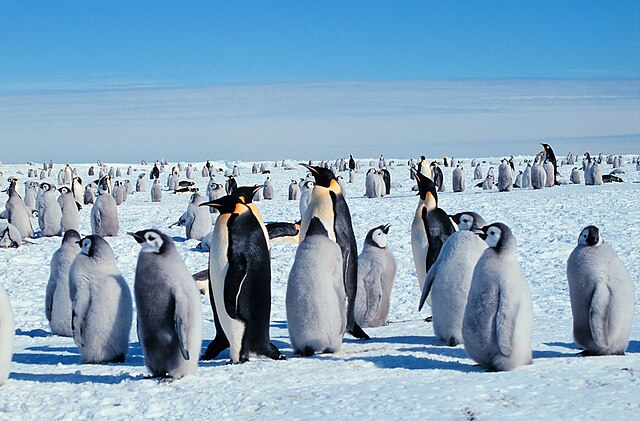
Eventually, both the chick and parents return to the sea and spend the rest of the summer feeding there. At the end of the summer the whole inland trip is repeated for all those penguins of breeding age, while the younger ones stay at the sea edge.
Conservation status
The Emperor Penguin, along with nine other species of penguin, is currently being considered for placement under the Endangered Species Protection Act. The primary reasons for this are declining food availability due to the effects of climate change, and industrial fisheries on the crustacean and fish populations. Other reasons for their placement on this list include such things as disease, foreign and introduced predators (this is more so for the other species of penguin than it is the Emperor), habitat destruction, and disturbance at breeding colonies by humans. The ruling for this will be introduced by November of this year, with protection commencing one year after.
Distribution map
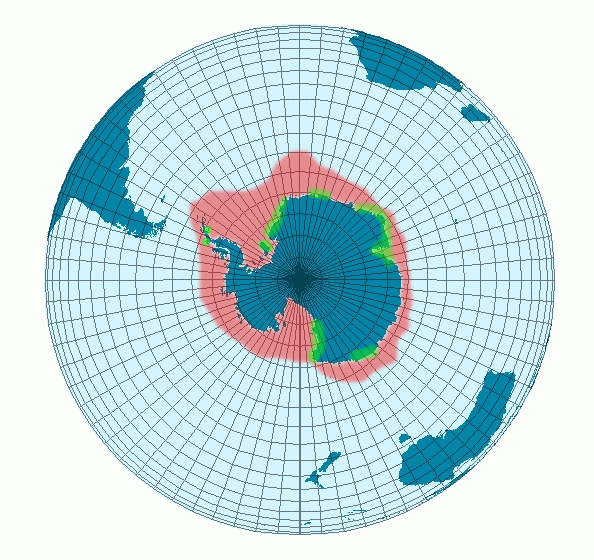
Habitat map and breeding areas. Red: areas where the Emperor Penguin lives. Green: areas where the Emperor Penguin breeds.
Food preference
Emperor penguins have a varied menu with some prey items being more important than others. One of the most frequently eaten prey species is the Antarctic silverfish Pleuragramma antarcticum. They also eat other fish, Antarctic krill and some species of squid.
An adult penguin eats 2 - 3 kg per day. When they need to fatten up before a moult or at the start of the breeding season, they can eat as much as 6 kg per day.
Breeding adults really have to fill up their stomachs before they return to the colony. THey need to feed their chicks and the colonies are often a long way from the fishing grounds.
Each chick needs about 42 kg of food for each parent.
Emperor penguins in a changing environment: how do they cope?
Emperor penguins like many seabirds have evolved a life strategy that is characterised by two main features: first, the birds are long-lived (up to at least 40 years), and second they have a low annual reproductive output. Each breeding pair can produce only one chick per year. Emperor penguins breed during the Antarctic winter and only the male incubates the single egg. Should the egg be lost or the chick die there is no chance for a pair to breed again in that season. Chick mortality tends to be high once the youngsters leave the colony and head for the ocean. They have to learn very quickly about predators and how and what to hunt. It is not surprising that maybe only a third of each year's cohort may live to their first birthday.

How deep can an Emperor penguin dive?
Since we cannot follow the penguins out to sea we rely on electronic instruments to record their activities. The time-depth recorders are mini-computers that record the time when a penguin dives, how long it dives for and to what depth it dives. From these records we also learn how much time the birds spent in the water, how long they rest between dives and at what time of day they are most active.
Graph showing the deepest dive profile - the deepest dive is 564 m and four more around 500 m.
Emperor penguins dive deeper than any other bird. Most of their dives are between 100 and 200 m but occasionally they go a lot deeper. The deepest dive we have on record (red line in the figure above) was an incredible 565 m deep!! The penguin had been diving to over 450 m quite regularly until it finally reach this enormous depth!
Penguins have to hold their breath when they dive. How long they hold their breath for depends on how deep they dive and how fast they move. On average, Emperor penguins dive for 3 to 6 minutes, but they can dive for longer. Among many thousands of dives we recorded two that lasted 22 minutes!! That is a very long time even for an excellent diver like an Emperor penguin.
Emperor penguins could march to extinction if nations fail to halt climate change
by Stephanie Jenouvrier, The Conversation
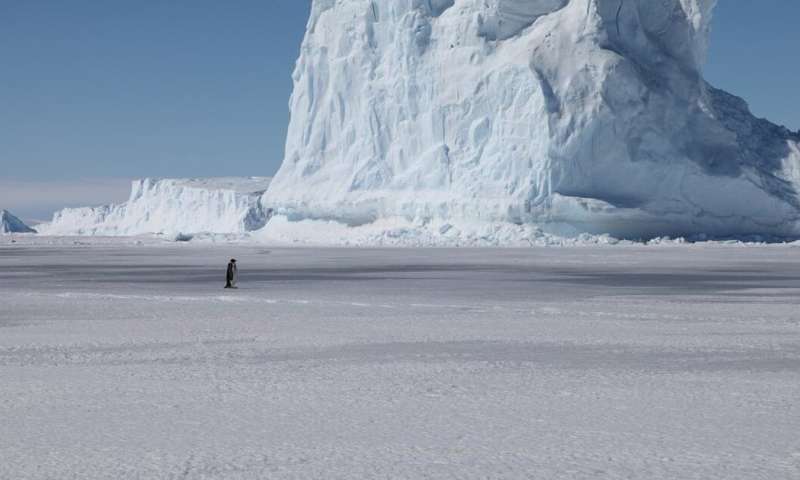
Emperor penguin in Antarctica. Credit: Stephanie Jenouvrier, CC BY-ND
The concept of a canary in a coal mine – a sensitive species that provides an alert to danger—originated with British miners, who carried actual canaries underground through the mid-1980s to detect the presence of deadly carbon monoxide gas. Today another bird, the emperor penguin, is providing a similar warning about the planetary effects of burning fossil fuels.
As a seabird ecologist, I develop mathematical models to understand and predict how seabirds respond to environmental change. My research integrates many areas of science, including the expertise of climatologists, to improve our ability to anticipate future ecological consequences of climate change.
Most recently, I worked with colleagues to combine what we know about the life history of emperor penguins with different potential climate scenarios outlined in the 2015 Paris Agreement, to combat climate change and adapt to its effects. We wanted to understand how climate change could affect this iconic species, whose unique life habits were documented in the award-winning film "March of the Penguins."
Our newly published study found that if climate change continues at its current rate, emperor penguins could virtually disappear by the year 2100 due to loss of Antarctic sea ice. However, a more aggressive global climate policy can halt the penguins' march to extinction.
Carbon dioxide in Earth's atmosphere
As many scientific reports have shown, human activities are increasing carbon dioxide concentrations in Earth's atmosphere, which is warming the planet. Today atmospheric CO2 levels stand at slightly over 410 parts per million, well above anything the planet has experienced in millions of years.
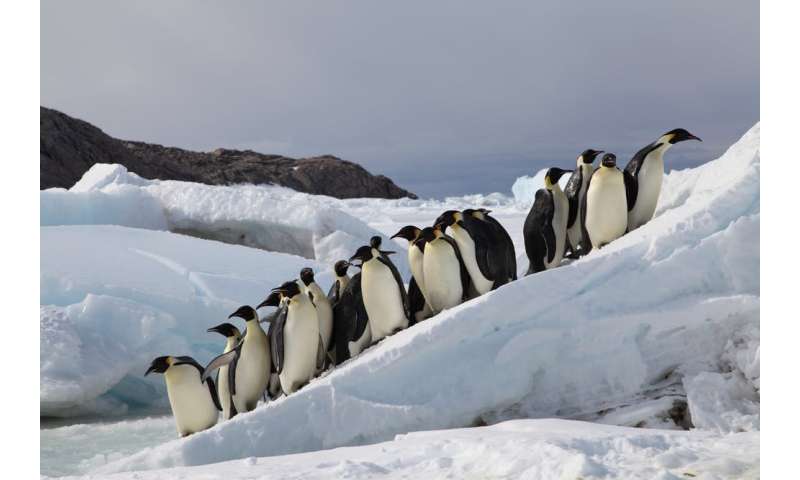
Emperor Penguins breeding on sea ice in Terre Adélie, Antarctica. Credit: Stephanie Jenouvrier, CC BY-ND
If this trend continues, scientists project that CO2 in the atmosphere could reach 950 parts per million by 2100. These conditions would produce a very different world from today's.
Emperor penguins are living indicators whose population trends can illustrate the consequences of these changes. Although they are found in Antarctica, far from human civilization, they live in such delicate balance with their rapidly changing environment that they have become modern-day canaries.
A fate tied to sea ice
I have spent almost 20 years studying emperor penguins' unique adaptations to the harsh conditions of their sea ice home. Each year, the surface of the ocean around Antarctica freezes over in the winter and melts back in summer. Penguins use the ice as a home base for breeding, feeding and molting, arriving at their colony from ocean waters in March or April after sea ice has formed for the Southern Hemisphere's winter season.
In mid-May the female lays a single egg. Throughout the winter, males keep the eggs warm while females make a long trek to open water to feed during the most unforgiving weather on Earth.
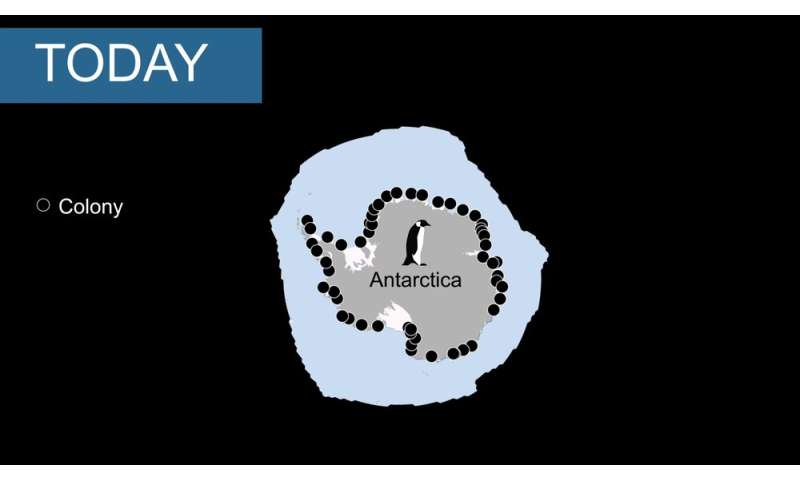
Fifty-four known emperor penguin colonies around Antarctica (black dots) and sea ice cover (blue color). Stephanie Jenouvrier, CC BY-ND
When female penguins return to their newly hatched chicks with food, the males have fasted for four months and lost almost half their weight. After the egg hatches, both parents take turns feeding and protecting their chick. In September, the adults leave their young so that they can both forage to meet their chick's growing appetite. In December, everyone leaves the colony and returns to the ocean.
Throughout this annual cycle, the penguins rely on a sea ice "Goldilocks zone" of conditions to thrive. They need openings in the ice that provide access to the water so they can feed, but also a thick, stable platform of ice to raise their chicks.
Penguin population trends
For more than 60 years, scientists have extensively studied one emperor penguin colony in Antarctica, called Terre Adélie. This research has enabled us to understand how sea ice conditions affect the birds' population dynamics. In the 1970s, for example, the population experienced a dramatic decline when several consecutive years of low sea ice cover caused widespread deaths among male penguins.
Over the past 10 years, my colleagues and I have combined what we know about these relationships between sea ice and fluctuations in penguin life histories to create a demographic model that allows us to understand how sea ice conditions affect the abundance of emperor penguins, and to project their numbers based on forecasts of future sea ice cover in Antarctica.
Once we confirmed that our model successfully reproduced past observed trends in emperor penguin populations around all Antarctica, we expanded our analysis into a species-level threat assessment.
Emperor penguin fathers incubate a single egg until it hatches.
Climate conditions determine emperor penguins' fate
When we used a climate model linked to our population model to project what is likely to happen to sea ice if greenhouse gas emissions continue on their present trend, we found that all 54 known emperor penguin colonies would be in decline by 2100, and 80% of them would be quasi-extinct. Accordingly, we estimate that the total number of emperor penguins will decline by 86% relative to its current size of roughly 250,000 if nations fail to reduce their carbon dioxide emissions.
However, if the global community acts to reduce greenhouse gas emissions and succeeds in stabilizing average global temperatures at 1.5 degrees Celsius (3 degrees Faherenheit) above pre-industrial levels, we estimate that emperor penguin numbers would decline by 31% – still drastic, but viable.
Less-stringent cuts in greenhouse gas emissions, leading to a global temperature rise of 2°C, would result in a 44% decline.
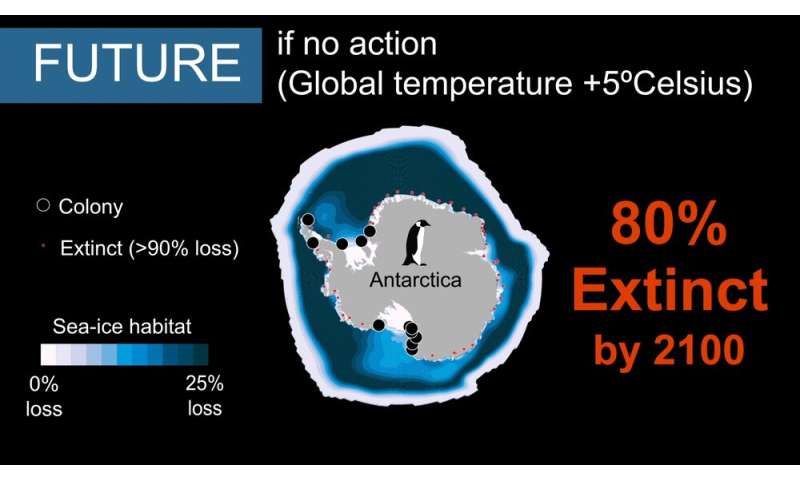
Without action to reduce global carbon dioxide emissions, sea ice loss (shown in blue) will eradicate most emperor penguin colonies by 2100. Credit: Stephanie Jenouvrier, CC BY-ND
Our model indicates that these population declines will occur predominately in the first half of this century. Nonetheless, in a scenario in which the world meets the Paris climate targets, we project that the global emperor penguin population would nearly stabilize by 2100, and that viable refuges would remain available to support some colonies.
In a changing climate, individual penguins may move to new locations to find more suitable conditions. Our population model included complex dispersal processes to account for these movements. However, we find that these actions are not enough to offset climate-driven global population declines. In short, global climate policy has much more influence over the future of emperor penguins than the penguins' ability to move to better habitat.
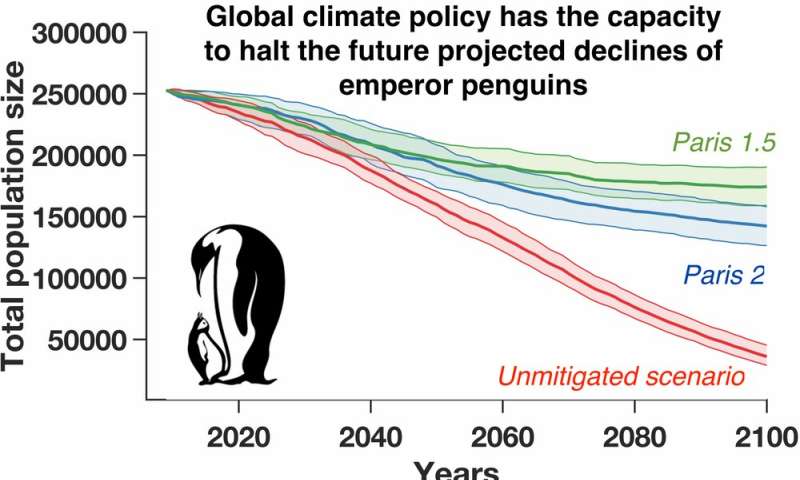
Global action to limit climate change through 2100 could greatly improve emperor penguins’ persistence/viability. Credit: Stephanie Jenouvrier, CC BY-ND
Our findings starkly illustrate the far-reaching implications of national climate policy decisions. Curbing carbon dioxide emissions has critical implications for emperor penguins and an untold number of other species for which science has yet to document such a plain-spoken warning.
phys.org/news/2019-11-emperor-penguins-extinction-nations-halt.html

Scientific classification
Kingdom: Animalia
Phylum: Chordata
Class: Aves
Order: Sphenisciformes
Family: Spheniscidae
Genus: Aptenodytes
Species: Aptenodytes forsteri
The Emperor Penguin (Aptenodytes forsteri) is the tallest and heaviest of all living penguin species. It is endemic to Antarctica, and is the only penguin species that breeds during the Antarctic winter. Emperor Penguins mainly eat crustaceans (such as krill) but also occasionally take small fish and squid. In the wild, Emperor Penguins typically live for 20 years, but some records indicate a maximum lifespan of around 40 years. The Emperor Penguin should not be confused with the closely related King Penguin or the Royal Penguin.
Ecology and behavior
Emperor Penguins are social animals, both foraging and nesting in groups. In severe weather the penguins huddle together for protection. They may be active day or night. Mature adults travel throughout most of the year between the nesting area and foraging areas in the ocean. From January to March, Emperor Penguins disperse into the oceans, traveling and foraging in groups. It is estimated that there are at least 250,000 Emperor Penguins, distributed into as many as 40 independent Antarctic colonies.
They normally dive to between 150 and 250 m (490 to 820 ft), although they can venture deeper, the deepest diving on record being 565 m (1870 ft). The longest they can hold their breath when underwater is 15 to 20 minutes. Their swimming speed is 6 to 9 km/h (4 to 6 mph), but they can achieve up to 19 km/h (12 mph) in short bursts. One of their feeding strategies is to dive to about 50 m (164 ft), where they can easily spot the sub-ice fish, Pagothenia borchgrevinki, swimming against the under surface of the sea-ice, which they then catch. They then dive again and repeat the sequence about half a dozen times before surfacing to breathe. They may also blow bubbles into the cracks in the ice to drive out the hiding fish.
On land they alternate between walking with a wobbling gait and sliding over the ice on their bellies, propelled by their feet and their flipper-like wings.
As a defense against the cold, Emperor Penguins stand in compact huddles (also known as the turtle formation) ranging in size between ten and many hundreds of birds, each leaning forward on a neighbor. Those on the outside tend to shuffle slowly around the edge of the turtle producing a slow churning action, giving each bird a turn on the inside and the outside.

Predators
In the wild, the Emperor Penguin's predators include birds, which prey on chicks and eggs, and aquatic mammals which prey upon both chicks and adult penguins. The primary bird predators are the Antarctic Giant Petrel (Macronectes giganteus) and the Skua. The primary aquatic mammal predators are the Leopard Seal, and Orca.
Reproduction
Emperor Penguins first begin to breed at approximately five years of age. Emperor penguins travel about 90 km (56 mi) inland to reach the breeding site. The penguins start courtship in March or April, when the temperature can be as low as –40°C. Emperor Penguins are serially monogamous. They have only one mate each year, and stay faithful to that mate. However, the next year, most end up with different mates. Although they attempt to locate the previous year's mate in the next breeding season, most cannot find each other and choose a new mate.
In May or June, the female penguin lays one 450 gram (1 lb) egg, but at this point her nutritional reserves are exhausted and she must immediately return to the sea to feed. Very carefully, she transfers the egg to the male, who incubates the egg in his brood pouch for about 65 days consecutively without food by surviving on his fat reserves and spending the majority of the time sleeping to conserve energy. The transfer of the egg can be awkward and difficult, and many couples drop the egg in the process. When this happens, the chick inside is immediately lost as the egg cannot withstand the low temperatures on the icy ground. To survive the cold and winds of up to 200 km/h (120 mph), the males huddle together, taking turns in the middle of the huddle. They have also been observed with their backs to the wind to conserve body heat. If the chick hatches before the mother's return, the father sets the chick on his feet and covers it with his pouch, feeding it a white, milky substance produced by a gland in his esophagus.
After about two months, the female returns. She finds her mate among the hundreds of fathers via his call and takes over caring for the chick, feeding it by regurgitating the food that she has stored in her stomach. The male then leaves to take his turn at sea. His trip is slightly shorter than before, because the melting of ice in the summer gradually decreases the distance between the breeding site and the open sea. After another few weeks, the male returns and both parents tend to the chick by keeping it off the ice and feeding it regurgitated food. About two months after the egg hatches, as the weather becomes milder, the chicks huddle in a crèche for warmth and protection, still fed by their parents.

Eventually, both the chick and parents return to the sea and spend the rest of the summer feeding there. At the end of the summer the whole inland trip is repeated for all those penguins of breeding age, while the younger ones stay at the sea edge.
Conservation status
The Emperor Penguin, along with nine other species of penguin, is currently being considered for placement under the Endangered Species Protection Act. The primary reasons for this are declining food availability due to the effects of climate change, and industrial fisheries on the crustacean and fish populations. Other reasons for their placement on this list include such things as disease, foreign and introduced predators (this is more so for the other species of penguin than it is the Emperor), habitat destruction, and disturbance at breeding colonies by humans. The ruling for this will be introduced by November of this year, with protection commencing one year after.
Distribution map

Habitat map and breeding areas. Red: areas where the Emperor Penguin lives. Green: areas where the Emperor Penguin breeds.
Food preference
Emperor penguins have a varied menu with some prey items being more important than others. One of the most frequently eaten prey species is the Antarctic silverfish Pleuragramma antarcticum. They also eat other fish, Antarctic krill and some species of squid.
An adult penguin eats 2 - 3 kg per day. When they need to fatten up before a moult or at the start of the breeding season, they can eat as much as 6 kg per day.
Breeding adults really have to fill up their stomachs before they return to the colony. THey need to feed their chicks and the colonies are often a long way from the fishing grounds.
Each chick needs about 42 kg of food for each parent.
Emperor penguins in a changing environment: how do they cope?
Emperor penguins like many seabirds have evolved a life strategy that is characterised by two main features: first, the birds are long-lived (up to at least 40 years), and second they have a low annual reproductive output. Each breeding pair can produce only one chick per year. Emperor penguins breed during the Antarctic winter and only the male incubates the single egg. Should the egg be lost or the chick die there is no chance for a pair to breed again in that season. Chick mortality tends to be high once the youngsters leave the colony and head for the ocean. They have to learn very quickly about predators and how and what to hunt. It is not surprising that maybe only a third of each year's cohort may live to their first birthday.

How deep can an Emperor penguin dive?
Since we cannot follow the penguins out to sea we rely on electronic instruments to record their activities. The time-depth recorders are mini-computers that record the time when a penguin dives, how long it dives for and to what depth it dives. From these records we also learn how much time the birds spent in the water, how long they rest between dives and at what time of day they are most active.
Graph showing the deepest dive profile - the deepest dive is 564 m and four more around 500 m.
Emperor penguins dive deeper than any other bird. Most of their dives are between 100 and 200 m but occasionally they go a lot deeper. The deepest dive we have on record (red line in the figure above) was an incredible 565 m deep!! The penguin had been diving to over 450 m quite regularly until it finally reach this enormous depth!
Penguins have to hold their breath when they dive. How long they hold their breath for depends on how deep they dive and how fast they move. On average, Emperor penguins dive for 3 to 6 minutes, but they can dive for longer. Among many thousands of dives we recorded two that lasted 22 minutes!! That is a very long time even for an excellent diver like an Emperor penguin.
Emperor penguins could march to extinction if nations fail to halt climate change
by Stephanie Jenouvrier, The Conversation

Emperor penguin in Antarctica. Credit: Stephanie Jenouvrier, CC BY-ND
The concept of a canary in a coal mine – a sensitive species that provides an alert to danger—originated with British miners, who carried actual canaries underground through the mid-1980s to detect the presence of deadly carbon monoxide gas. Today another bird, the emperor penguin, is providing a similar warning about the planetary effects of burning fossil fuels.
As a seabird ecologist, I develop mathematical models to understand and predict how seabirds respond to environmental change. My research integrates many areas of science, including the expertise of climatologists, to improve our ability to anticipate future ecological consequences of climate change.
Most recently, I worked with colleagues to combine what we know about the life history of emperor penguins with different potential climate scenarios outlined in the 2015 Paris Agreement, to combat climate change and adapt to its effects. We wanted to understand how climate change could affect this iconic species, whose unique life habits were documented in the award-winning film "March of the Penguins."
Our newly published study found that if climate change continues at its current rate, emperor penguins could virtually disappear by the year 2100 due to loss of Antarctic sea ice. However, a more aggressive global climate policy can halt the penguins' march to extinction.
Carbon dioxide in Earth's atmosphere
As many scientific reports have shown, human activities are increasing carbon dioxide concentrations in Earth's atmosphere, which is warming the planet. Today atmospheric CO2 levels stand at slightly over 410 parts per million, well above anything the planet has experienced in millions of years.

Emperor Penguins breeding on sea ice in Terre Adélie, Antarctica. Credit: Stephanie Jenouvrier, CC BY-ND
If this trend continues, scientists project that CO2 in the atmosphere could reach 950 parts per million by 2100. These conditions would produce a very different world from today's.
Emperor penguins are living indicators whose population trends can illustrate the consequences of these changes. Although they are found in Antarctica, far from human civilization, they live in such delicate balance with their rapidly changing environment that they have become modern-day canaries.
A fate tied to sea ice
I have spent almost 20 years studying emperor penguins' unique adaptations to the harsh conditions of their sea ice home. Each year, the surface of the ocean around Antarctica freezes over in the winter and melts back in summer. Penguins use the ice as a home base for breeding, feeding and molting, arriving at their colony from ocean waters in March or April after sea ice has formed for the Southern Hemisphere's winter season.
In mid-May the female lays a single egg. Throughout the winter, males keep the eggs warm while females make a long trek to open water to feed during the most unforgiving weather on Earth.

Fifty-four known emperor penguin colonies around Antarctica (black dots) and sea ice cover (blue color). Stephanie Jenouvrier, CC BY-ND
When female penguins return to their newly hatched chicks with food, the males have fasted for four months and lost almost half their weight. After the egg hatches, both parents take turns feeding and protecting their chick. In September, the adults leave their young so that they can both forage to meet their chick's growing appetite. In December, everyone leaves the colony and returns to the ocean.
Throughout this annual cycle, the penguins rely on a sea ice "Goldilocks zone" of conditions to thrive. They need openings in the ice that provide access to the water so they can feed, but also a thick, stable platform of ice to raise their chicks.
Penguin population trends
For more than 60 years, scientists have extensively studied one emperor penguin colony in Antarctica, called Terre Adélie. This research has enabled us to understand how sea ice conditions affect the birds' population dynamics. In the 1970s, for example, the population experienced a dramatic decline when several consecutive years of low sea ice cover caused widespread deaths among male penguins.
Over the past 10 years, my colleagues and I have combined what we know about these relationships between sea ice and fluctuations in penguin life histories to create a demographic model that allows us to understand how sea ice conditions affect the abundance of emperor penguins, and to project their numbers based on forecasts of future sea ice cover in Antarctica.
Once we confirmed that our model successfully reproduced past observed trends in emperor penguin populations around all Antarctica, we expanded our analysis into a species-level threat assessment.
Emperor penguin fathers incubate a single egg until it hatches.
Climate conditions determine emperor penguins' fate
When we used a climate model linked to our population model to project what is likely to happen to sea ice if greenhouse gas emissions continue on their present trend, we found that all 54 known emperor penguin colonies would be in decline by 2100, and 80% of them would be quasi-extinct. Accordingly, we estimate that the total number of emperor penguins will decline by 86% relative to its current size of roughly 250,000 if nations fail to reduce their carbon dioxide emissions.
However, if the global community acts to reduce greenhouse gas emissions and succeeds in stabilizing average global temperatures at 1.5 degrees Celsius (3 degrees Faherenheit) above pre-industrial levels, we estimate that emperor penguin numbers would decline by 31% – still drastic, but viable.
Less-stringent cuts in greenhouse gas emissions, leading to a global temperature rise of 2°C, would result in a 44% decline.

Without action to reduce global carbon dioxide emissions, sea ice loss (shown in blue) will eradicate most emperor penguin colonies by 2100. Credit: Stephanie Jenouvrier, CC BY-ND
Our model indicates that these population declines will occur predominately in the first half of this century. Nonetheless, in a scenario in which the world meets the Paris climate targets, we project that the global emperor penguin population would nearly stabilize by 2100, and that viable refuges would remain available to support some colonies.
In a changing climate, individual penguins may move to new locations to find more suitable conditions. Our population model included complex dispersal processes to account for these movements. However, we find that these actions are not enough to offset climate-driven global population declines. In short, global climate policy has much more influence over the future of emperor penguins than the penguins' ability to move to better habitat.

Global action to limit climate change through 2100 could greatly improve emperor penguins’ persistence/viability. Credit: Stephanie Jenouvrier, CC BY-ND
Our findings starkly illustrate the far-reaching implications of national climate policy decisions. Curbing carbon dioxide emissions has critical implications for emperor penguins and an untold number of other species for which science has yet to document such a plain-spoken warning.
phys.org/news/2019-11-emperor-penguins-extinction-nations-halt.html


